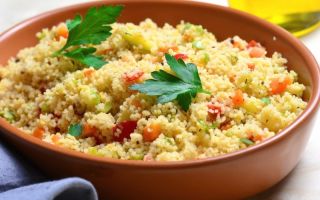Content
- 1 What is this cereal and how is it obtained
- 2 The chemical composition of couscous
- 3 Nutritional value and calorie content of couscous
- 4 Useful properties of couscous
- 5 Is it possible couscous
- 6 The benefits and harms of couscous for some diseases
- 7 Is couscous good for weight loss
- 8 Couscous in traditional medicine
- 9 The use of couscous in home cosmetology
- 10 How to cook delicious couscous
- 11 Harm of couscous and contraindications
- 12 How to choose and store couscous
- 13 Conclusion
The benefits and harms of couscous are a matter of interest to fans of unusual cereals. To answer it, you need to carefully study the properties of exotic cereals and find out where and how it is used.
What is this cereal and how is it obtained
Couscous is a cereal native to North Africa. The product first appeared in the Berber tribes, and then quickly spread to neighboring countries - Tunisia, Libya, Morocco, Algeria. Nowadays, couscous can be found in stores all over the world, people value cereals for their pleasant taste and numerous beneficial properties.
The technology for preparing the product has remained practically unchanged since ancient times. To obtain it, semolina, wheat, rice or other cereals are moistened with water and sprinkled with flour, and then shaken inside a sieve until only small dense granules of the "improved" cereal remain in it. Both the home and the industrial process of making couscous looks about the same, but, of course, in the factory, cereals are produced in large volumes in short periods of time.
At the moment, many cereals are used as raw materials. At the same time, a product made on the basis of wheat or semolina is considered traditional.
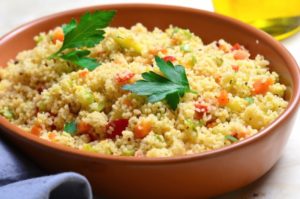
The chemical composition of couscous
Unusual groats have many beneficial properties. They are due to the composition of the product, which includes:
- calcium, magnesium and potassium;
- zinc, copper and manganese;
- phosphorus, iron and sodium;
- vitamin E, or tocopherol;
- vitamin K;
- pantothenic and folic acid;
- vitamins B1 and B2;
- pyridoxine;
- fatty acid;
- nicotinic acid PP;
- fiber and ash;
- amino acids.
Nutritional value and calorie content of couscous
The cereal contains all the energy components - carbohydrates in the amount of 77.4 g, proteins, which occupy 12.8 g, and fats, which account for only 0.6 g.
The calorie content of couscous per 100 grams is 376 calories, which is quite a lot. True, when cooked, the nutritional value of couscous is reduced to 112 calories per 100 g, but it still cannot be considered a completely dietary product.
Useful properties of couscous
The rich composition of this unusual cereal gives it many useful properties. Couscous constantly present in the diet:
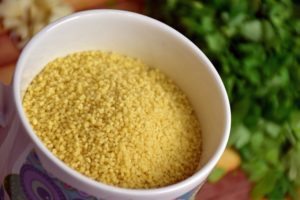
- helps to get rid of constipation and normalizes the bowel emptying regime;
- protects the walls of blood vessels from the formation of atherosclerotic plaques and reduces harmful cholesterol;
- has a beneficial effect on the nervous system due to the presence of B vitamins;
- strengthens the immune system and protects the body from viruses and infections;
- has a positive effect on the joints - it serves as the prevention of arthritis, osteoporosis, arthrosis;
- prevents the formation of kidney stones;
- improves heart function and protects against heart attacks and strokes;
- has a tonic and strengthening effect on hair and skin.
The product is very easy to digest, this is the benefit of couscous for breakfast. Especially the porridge is recommended for use by athletes, children and elderly people.
Is it possible couscous
The health benefits and harms of couscous may vary from person to person. It is necessary to find out in advance whether it is possible to eat porridge under certain conditions and what precautions must be taken.

During pregnancy
In the diet of a pregnant woman, the product will be of great benefit to both the woman and the fetus. Groats contain a large amount of folic acid and B vitamins, therefore, contributes to the healthy development of the fetus, and in addition, reduces the manifestations of toxicosis in women. The benefit of couscous porridge is that it helps prevent constipation, which future mothers often suffer from, and protects the body from developing anemia.
However, it must be remembered that the product contains a lot of carbohydrates. You cannot abuse them - it will be harmful, since it will lead to weight gain. It is better to eat meals based on a healthy product no more than twice a week.
When breastfeeding
The properties of cereals rarely cause allergies in infants, so it is allowed to use the product during lactation. True, it is recommended to start with small portions in order to make sure that the child's body reacts normally to the new product and no harm will be done.

For children
The benefits of couscous for children are undeniable, however, for the first time, you can offer it to your baby no earlier than 8 months of life, like any other cereals. Most cereals, including couscous, contain gluten. The properties of the substance can cause allergies even in adults and, moreover, gluten is dangerous for newborns.
After 8-10 months, the child can be offered first courses with couscous; cereals go well with vegetables, meat and even fruits. In order to avoid harm, the first portions should be minimal - no more than 1 teaspoon. If there is no negative reaction, then gradually the amount of couscous can be increased.
The benefits and harms of couscous for some diseases
In order for the beneficial properties of couscous porridge to manifest in full force and not cause harm to health, you need to know the rules for using the product for certain diseases. Sometimes couscous can be completely contraindicated or allowed in small quantities.
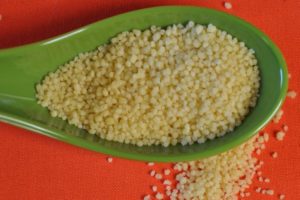
With pancreatitis
In the acute phase of the disease, couscous, like many other products, is strictly prohibited for use. But you can introduce cereals back into the diet within 2 weeks after the pain in the pancreas subsides.
During the period of remission, you can use couscous freely, but it is better to eat it no more than three times a week.
With diabetes
The product contains a lot of carbohydrates, and the glycemic index of couscous is 65 units. At first glance, it seems that the properties of cereals are poorly suited for the diet of diabetics.
However, in fact, you can use couscous for diabetes, but in small portions and no more than twice a week. The product does not provoke a sharp rise in glucose levels, and the fiber in its composition helps to maintain healthy intestinal function.
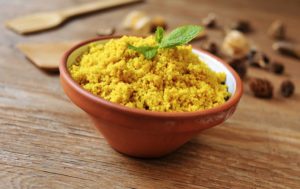
With gastritis
The benefits of couscous wheat grits are manifested even during an exacerbation of gastritis, its delicate structure does not irritate the inflamed gastric mucosa. True, when cooking porridge, it must be boiled especially carefully, and even better - chopped with a blender to a state of soft puree. You can use couscous for gastritis both as a separate dish and together with lean boiled meat and vegetables.
With cholecystitis
In case of inflammation of the gallbladder, couscous should be used carefully and only after thorough boiling and grinding of cereals. But in general, the properties of properly prepared porridge do not harm the body and do not have an irritating effect.
Is couscous good for weight loss
With all its beneficial properties on a diet, couscous will rather harm. Its calorie content is too high to be considered a standalone weight loss product.
However, in small quantities it can still be consumed with vegetables and meat dishes. The main thing is not to forget to monitor the daily calorie intake.
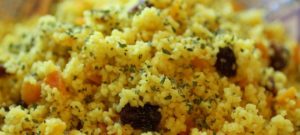
Couscous in traditional medicine
The beneficial properties of cereals are used, among other things, for medicinal purposes.
- Groats effectively increase the level of hemoglobin, so traditional medicine recommends using it for anemia.
- Introducing couscous into a regular diet is advised for joint pain and hair loss - B vitamins in the product will have a healing effect.
- Eating couscous is recommended for the prevention of colds, as well as for the elimination of depression and chronic fatigue syndrome.
The use of couscous in home cosmetology
The health benefits of couscous are found in homemade beauty recipes. The properties of the product are used to improve the condition of the skin and nails. Groats bring quick positive results.
Facial mask
In order to cleanse the skin of the face and increase its elasticity, you can prepare a useful scrub mask:
- Mix 1 large spoonful of cereal with egg yolk;
- add 1 teaspoon of honey;
- spread over the skin with light massage movements and leave for a quarter of an hour.
The benefit will be that couscous grains will help to gently remove dead skin particles. And vitamins in the composition of cereals in combination with other ingredients will have a moisturizing effect.
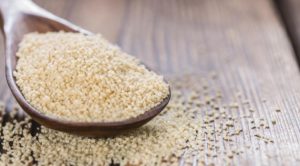
Mask for the growth and strengthening of nails
B vitamins present in the product will help to strengthen brittle nail plates. A couple of large tablespoons of cereal should be mixed with the same amount of peach oil, add 1 teaspoon of almond oil and heat the mixture to a warm temperature.
A useful mask is applied to the nails, and then they are wrapped with foil or thick cosmetic gloves are put on for half an hour. With regular use, the product will noticeably improve the condition of the nails.
How to cook delicious couscous
The classic cereal recipe looks very simple.
- Bring 1.5 cups of water to a boil over high heat and salt to taste.
- After that, pour 1.5 cups of cereal with boiling water, cover with a lid and leave for 10 minutes to steam.
- Then the lid is removed and the softened couscous is kneaded with a spoon or fork.
The porridge is ready to eat - it can be served.
Couscous garnish with vegetables
Although porridge cooked in water is very healthy and has a pleasant taste, compound dishes using this cereal are of much greater interest. For example, you can make a vegetable side dish. It is done as follows:
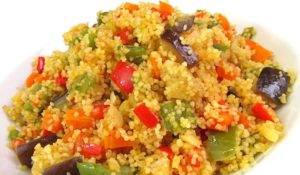
- Fresh carrots, a couple of onions and a bay leaf are placed in a saucepan, poured with water and put on fire. You can add some vegetable oil to the water.
- After the water boils, the vegetables are salted to taste, the heat is reduced and cooked until cooked until the carrots and onions are tender.
- In the meantime, dry couscous is poured into a deep container in an amount of about 200 g.
- The groats are poured with hot golden broth and covered with a lid for a quarter of an hour.
After 15 minutes, the aromatic and tasty side dish will be completely ready. It remains to put it in a plate, decorate with boiled vegetables and sprinkle with herbs - dill or parsley. This vegetable side dish will be a great addition to any meat dish.
Couscous soup
You can make not only a side dish or porridge from cereals, but also a healthy soup. They do it like this:
- They put water on a medium heat, quickly cut a carrot and a couple of onions and send it to a saucepan when the water boils.
- Then add 100 g of chopped smoked brisket to the vegetables.
- Chop 1 pickled cucumber and 3 pickled tomatoes and add to the pot as well.
- Salt and pepper are poured into the soup to taste.
- As the last ingredient, lay 80 g of couscous.
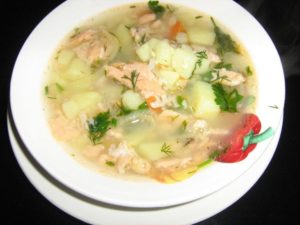
After that, the soup is boiled for literally 1-2 minutes, turn off the stove, close the pan with a lid and leave for 5 minutes, until the couscous softens. Quick soup takes only 20 minutes to prepare.
Harm of couscous and contraindications
Whatever the benefits of couscous, the product can cause harm to the body. Unusual groats are contraindicated in:
- obesity - couscous is too high in calories;
- gluten intolerance, if the substance is not absorbed by the intestines, then at least wheat and barley varieties of cereals will have to be abandoned.
Couscous should be used with caution in diabetes - the portions of porridge should be very small. The rest of the product is harmless and is approved for use by almost everyone.
How to choose and store couscous
In order for the porridge to please with its taste and benefits, it must be chosen correctly. The stores offer several varieties of couscous, produced on the basis of different cereals.
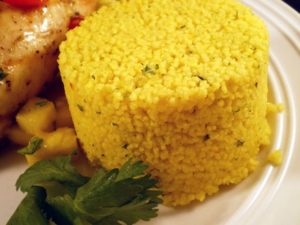
- The most useful is wheat couscous made from hard varieties - it contains the maximum amount of valuable properties and is allowed for consumption even with chronic bowel ailments. However, according to your tastes, you can choose cereals based on rice or barley.
- Any quality couscous consists of only two ingredients - cereals and water. If there is something else in the composition, the cereal can no longer be considered natural.
- When buying couscous, you need to look at the date of manufacture. If the shelf life is coming to an end, it is better not to purchase cereals - it will deteriorate before the packaging comes to an end.
The neatly closed couscous can be stored in a dark, dry and cool place for up to 10 months. It is best to keep the cereal away from spices or seasonings with strong flavors so that the couscous does not absorb their smells.
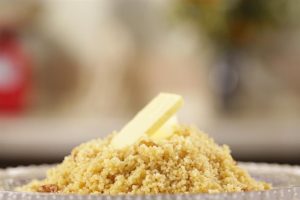
Conclusion
The benefits and harms of couscous depend mainly on the quality of the cereal. The product, produced according to the classical technology without unnecessary additives, has almost no contraindications, everyone can use it with pleasure and health benefits.

